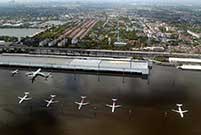

 |
| (File Photo) |
SEOUL, Jan. 10 -- A U.S. B-52 bomber, capable of delivering nuclear missile, was deployed on Sunday in South Korea in retaliation for the Democratic People's Republic of Korea (DPRK)'s fourth nuclear test.
The long-range bomber, which departed from the U.S. Anderson base in Guam on Sunday morning, arrived and flied over South Korea's Osan air base at about noon, South Korea's Yonhap news agency reported.
Air forces of South Korea and the United States made the joint announcement when the nuclear missile-mounted bomber arrived, Yonhap reported.
The B-52 bomber can infiltrate at the highest altitude of 55,000 feet, or 16.8 km, carrying 35 conventional bombs and 12 cruise missiles.
It can also deliver air-to-ground nuclear missiles with a range of 200 km and air-launched cruise missiles with a range of 2,500-3,000 km.
The deployment came as part of retaliatory measures after the DPRK said Wednesday it had successfully tested a hydrogen bomb.
If confirmed, it would mark the DPRK's first hydrogen bomb test and the fourth nuke test in total. Previous tests were conducted in 2006, 2009 and 2013.
In retaliation for the nuclear test, South Korea began blaring propaganda messages at Friday noon from speakers across the border into the DPRK, which called it an "act of declaring war."
The South Korean frontline units, near 11 sites where the set of loudspeakers restarted psychological warfare with anti-DPRK messages, have been on the highest alert.
The U.S. and South Korean militaries are reportedly considering additional retaliatory measures, which include the deployment in South Korea of the U.S. aircraft carrier Ronald Reagan currently in Yokosuka, Japan.
The retaliation also includes the deployment of a U.S. nuclear-powered submarine and F-22 stealth fighter.
Xinhuanet
U.S. B-52 bomber deployed in S. Korea in retaliation for DPRK's nuke test
English.news.cn 2016-01-10 12:23:39
SEOUL, Jan. 10 (Xinhua) -- A U.S. B-52 bomber, capable of delivering nuclear missile, was deployed on Sunday in South Korea in retaliation for the Democratic People's Republic of Korea (DPRK)'s fourth nuclear test.
The long-range bomber, which departed from the U.S. Anderson base in Guam on Sunday morning, arrived and flied over South Korea's Osan air base at about noon, South Korea's Yonhap news agency reported.
Air forces of South Korea and the United States made the joint announcement when the nuclear missile-mounted bomber arrived, Yonhap reported.
The B-52 bomber can infiltrate at the highest altitude of 55,000 feet, or 16.8 km, carrying 35 conventional bombs and 12 cruise missiles.
It can also deliver air-to-ground nuclear missiles with a range of 200 km and air-launched cruise missiles with a range of 2,500-3,000 km.
The deployment came as part of retaliatory measures after the DPRK said Wednesday it had successfully tested a hydrogen bomb.
If confirmed, it would mark the DPRK's first hydrogen bomb test and the fourth nuke test in total. Previous tests were conducted in 2006, 2009 and 2013.
In retaliation for the nuclear test, South Korea began blaring propaganda messages at Friday noon from speakers across the border into the DPRK, which called it an "act of declaring war."
The South Korean frontline units, near 11 sites where the set of loudspeakers restarted psychological warfare with anti-DPRK messages, have been on the highest alert.
The U.S. and South Korean militaries are reportedly considering additional retaliatory measures, which include the deployment in South Korea of the U.S. aircraft carrier Ronald Reagan currently in Yokosuka, Japan.
 "Rent me as your girlfriend!"
"Rent me as your girlfriend!" World's first 'underwater skyscraper'
World's first 'underwater skyscraper'  Top 10 weapons in the world in 2015
Top 10 weapons in the world in 2015 Are these the world’s scariest landing strips?
Are these the world’s scariest landing strips? In pics: Left behind children in China
In pics: Left behind children in China Eight modern day engineering marvels of China
Eight modern day engineering marvels of China Chinese beauty with sexiest bottom
Chinese beauty with sexiest bottom Charming female bodybuilders of Chengdu University
Charming female bodybuilders of Chengdu University Polish sports stars strip off for risqué calendar
Polish sports stars strip off for risqué calendar Top 20 hottest women in the world in 2014
Top 20 hottest women in the world in 2014 Top 10 hardest languages to learn
Top 10 hardest languages to learn 10 Chinese female stars with most beautiful faces
10 Chinese female stars with most beautiful faces China’s Top 10 Unique Bridges, Highways and Roads
China’s Top 10 Unique Bridges, Highways and Roads Trapped bi-love
Trapped bi-love Online war on terror
Online war on terror A bite of Spring Festival
A bite of Spring Festival China’s No.1 drug village closely watched by police one year after crackdown
China’s No.1 drug village closely watched by police one year after crackdownDay|Week